Evaluation of Ideas: Proven Frameworks for Success
Discover effective methods for evaluation of ideas to transform concepts into market-winning innovations. Enhance your decision-making today!
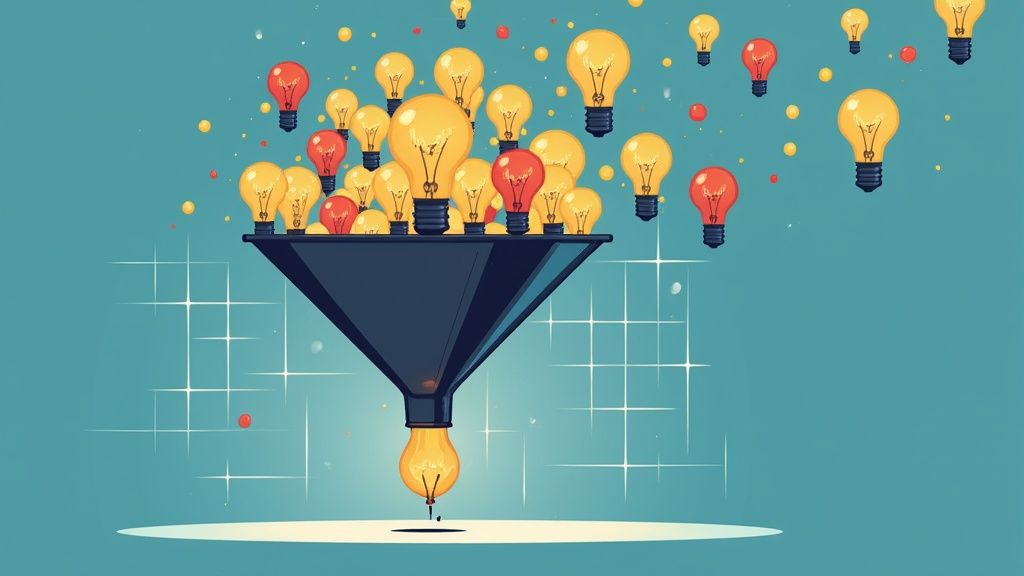
Why Smart Idea Evaluation Makes or Breaks Innovation
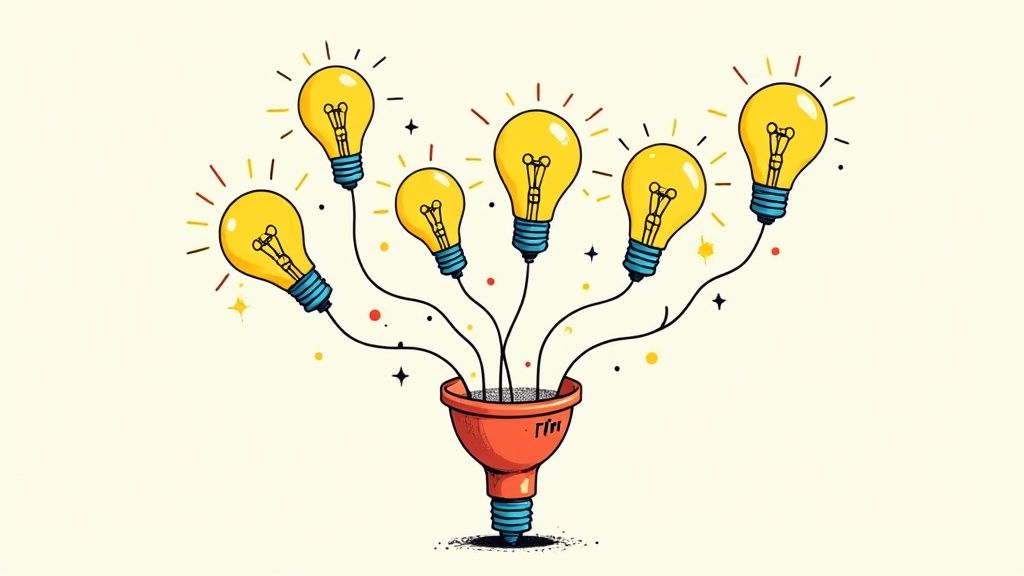
Let's be honest: many great ideas never get off the ground. This isn't because of a lack of creativity. It's often due to a failure in idea evaluation. Effective evaluation is the essential link between brainstorming and successful implementation. Before committing to a new venture, it's critical to validate your business idea using practical, proven strategies. This helps determine which concepts are truly valuable and which are likely to be a waste of time and resources.
Imagine an architect designing a magnificent skyscraper without first analyzing the soil. The building might look impressive in the blueprints, but a weak foundation will inevitably lead to disaster. Similarly, ideas without a structured evaluation process are vulnerable to failure. This can lead to wasted resources, lost market opportunities, and something called innovation fatigue, where teams become discouraged and creativity suffers.
Without a solid evaluation process, organizations may pursue ideas that initially seem promising but lack real-world viability. This is why using established evaluation frameworks is essential. These frameworks offer a structured approach, guiding you from initial concept to practical application and providing a roadmap for success.
Common Idea Evaluation Mistakes
Many organizations stumble over common pitfalls during the idea evaluation process. Understanding these mistakes is crucial for developing a more effective system. This applies not only to business but also to other areas, like evaluating public policies. For instance, the Global State of Democracy (GSoD) Indices use quantitative metrics to evaluate democratic performance in 173 countries. Their methodology reveals the challenges inherent in evaluation, including how sample sizes adjust for region-specific complexities. You can learn more about their detailed statistics here. This example demonstrates that even seemingly objective assessments require careful design and interpretation.
To help illustrate these common mistakes and how to avoid them, let's look at the following table:
Common Idea Evaluation Mistakes: A comparison of frequent mistakes organizations make when evaluating ideas and their potential consequences.
| Evaluation Mistake | Potential Consequence | Better Approach |
|---|---|---|
| Relying solely on gut feeling | Biased decisions, missed opportunities | Incorporate data-driven metrics |
| Lack of clear criteria | Inconsistent evaluations, unclear priorities | Establish weighted criteria based on strategic goals |
| Ignoring stakeholder feedback | Products that miss the mark, internal conflict | Integrate user feedback throughout the process, using tools like Saylo for streamlined collection and analysis. |
| Insufficient resource allocation | Inability to fully explore promising ideas | Allocate resources based on evaluation results |
This table highlights the importance of structured evaluation. By avoiding these common mistakes and adopting the better approaches listed, organizations can significantly improve their decision-making process. This leads to more successful innovation outcomes.
Successful companies understand that a structured approach is crucial. Companies like 3M and Atlassian use dedicated evaluation frameworks to filter through numerous ideas, identifying those with the highest potential for success. This helps them spot truly valuable concepts and discard those that, while initially appealing, lack real-world viability. Consider the impact of user feedback: How user feedback can make or break your product. This emphasizes the value of external perspectives during the evaluation process. In the end, smart idea evaluation isn’t just one step in the innovation process – it's the very foundation upon which successful innovation is built.
Powerful Frameworks for Evaluation of Ideas That Actually Work
Stop drowning in a sea of ideas. A systematic approach to evaluation is key to separating game-changing concepts from fleeting fads. This is where proven frameworks come into play, providing structure and clarity to your idea evaluation process.
Key Frameworks for Idea Evaluation
Several powerful frameworks can bring order to the chaos of brainstorming. Three popular choices include the Innovation Ambition Matrix, the Novelty-Utility Matrix, and Stage-Gate Processes. Each offers a unique perspective for assessing your ideas.
Innovation Ambition Matrix: This framework helps categorize ideas based on their potential impact and feasibility. It encourages you to think beyond incremental improvements and consider disruptive innovations.
Novelty-Utility Matrix: This matrix focuses on balancing an idea's novelty with its usefulness. It's a great tool to visualize the trade-offs between these two crucial elements.
Stage-Gate Processes: This framework provides a structured, step-by-step approach. Each concept must pass through specific gates before advancing to the next stage, promoting thoroughness and reducing risk.
Companies like Google and Procter & Gamble use these frameworks to filter their ideas, ensuring they invest time and resources wisely. Adapting these systems to your specific needs is critical. What works for a large corporation may not be suitable for a startup. Choosing the right framework depends on your organizational context, the type of innovation you're pursuing, and your overall objectives.
Essential Evaluation Criteria
Regardless of your chosen framework, certain criteria are essential for any effective evaluation system.
Market Potential: How big is the target market? What's the potential for growth?
Technical Feasibility: Can we build this? Do we have the necessary technology and expertise?
Financial Viability: What are the projected costs and returns? Is this a sustainable investment?
Strategic Alignment: Does this idea align with our overall business strategy and long-term goals?
Impact: How will this idea affect our customers, employees, and the broader community? Consider potential negative impacts and how to mitigate them.
Weighting these factors appropriately is crucial. For example, a social enterprise might prioritize impact over financial returns, while a for-profit company might do the opposite. For further insights on gathering valuable feedback, check out this article on how to master the product feedback loop.
Visualizing Evaluation Data
The following data chart illustrates how different companies prioritize evaluation criteria. It breaks down the percentage assigned to each criterion by three distinct companies.
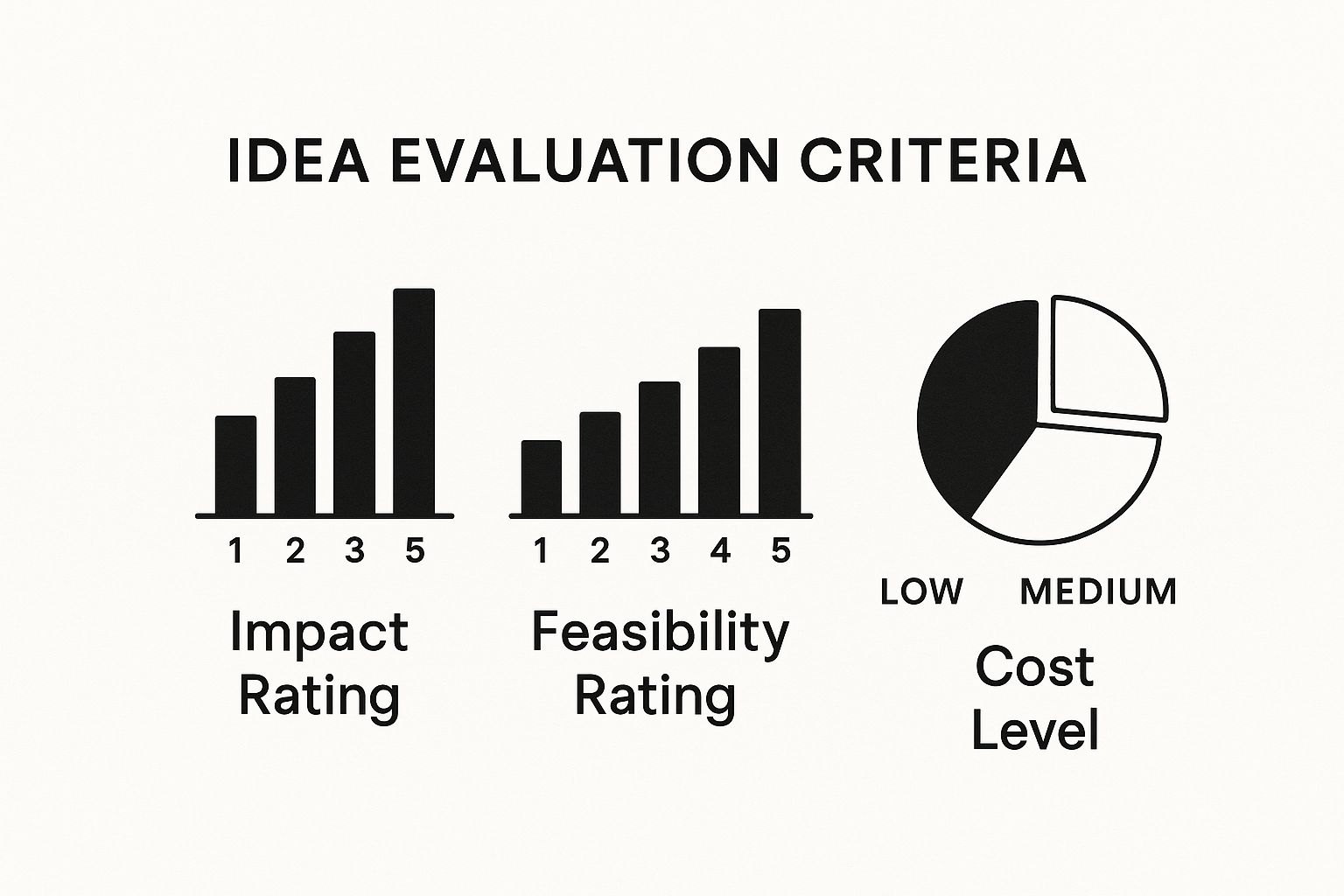
Company A emphasizes market potential at 60%, while Company B prioritizes technical feasibility at 75%. Company C values strategic alignment most highly, allocating 80% to this criterion. This visualization highlights the varied approaches and underscores the importance of a tailored evaluation system.
To further explore evaluation strategies, consider the growing field of development evaluation. The International Development Evaluation Association (IDEAS), with over 700 members in 90+ countries, demonstrates the global shift towards evidence-based decision-making. You can learn more about development evaluation here.
Introducing the following table, "Comparison of Idea Evaluation Frameworks," to provide a more detailed analysis of suitable frameworks for different organizational needs.
Comparison of Idea Evaluation Frameworks
| Framework | Best For | Key Strengths | Limitations |
|---|---|---|---|
| Innovation Ambition Matrix | Established organizations seeking disruptive innovation | Categorizes ideas based on impact and feasibility | Can be complex for early-stage companies |
| Novelty-Utility Matrix | Startups and smaller companies | Balances novelty and practicality | May not be suitable for complex projects |
| Stage-Gate Process | Larger organizations with structured processes | Provides a step-by-step approach, reduces risk | Can be rigid and time-consuming |
This table summarizes the strengths and weaknesses of each framework, assisting in selecting the best fit for your organization's specific circumstances. Choosing the right framework can significantly improve your idea evaluation process, leading to better innovation outcomes.
Numbers Don't Lie: Data-Driven Evaluation of Ideas
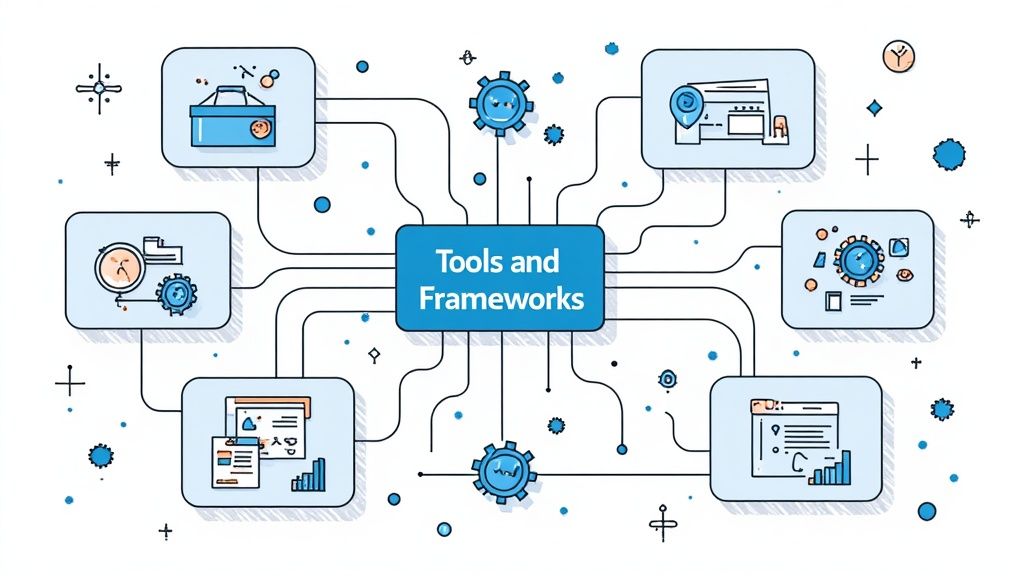
Successful innovation isn't just about brainstorming brilliant ideas; it's about objectively evaluating them. This means ditching gut feelings and embracing data-driven decision-making. This approach ensures you invest in concepts with the greatest potential for success. This section will delve into how scoring models, weighted criteria matrices, and economic assessment tools form the bedrock of effective idea evaluation.
Quantifying the Intangible
One of the biggest hurdles in idea evaluation is quantifying seemingly intangible aspects. How do you measure something like strategic alignment or brand impact? Luckily, practical solutions exist. Innovation leaders at companies like Amazon and Tesla develop specific metrics tailored to various idea types. This involves creating clear measurement scales for everything from product innovations to process improvements, minimizing subjective bias and ensuring consistent evaluations.
For instance, when evaluating a new product, a company might use a weighted scoring system. Factors like market size, potential profitability, and the competitive landscape each receive a numerical score based on pre-defined criteria. This allows for a more objective comparison of different ideas, even if they target different markets or require different investment levels. Effective monitoring and evaluation systems are also key to assessing development initiatives. Learn more about evaluation systems in developing countries here.
The Power of Visualization
Communicating complex evaluation data effectively is crucial for sound decision-making. Leading organizations leverage visualization techniques to make this data easily accessible. Charts, graphs, and dashboards can clearly present key metrics, highlighting the strengths and weaknesses of different ideas. This allows decision-makers to quickly grasp the core of the evaluation and make informed choices based on solid evidence. This clear presentation is particularly important when comparing multiple ideas or presenting complex data to stakeholders.
Avoiding the Pitfalls of Data
While data is essential, relying on it exclusively can be a trap. For example, focusing solely on financial projections can be misleading, especially for innovative ideas with uncertain market dynamics. Similarly, an excessive focus on achieving precise numerical scores can create a false sense of precision. This can lead to prematurely rejecting promising ideas that might have thrived with further development. The key lies in striking the right balance between quantitative and qualitative factors. You might be interested in: How to master customer feedback analysis.
Building a Robust Evaluation System
A robust idea evaluation system hinges on several key components:
Defined Criteria: Establish clear, measurable criteria aligned with organizational goals.
Weighted Scoring: Assign weights to each criterion based on its relative importance.
Data Collection: Gather relevant data using appropriate methods.
Visualization: Present data visually to facilitate understanding and comparison.
Regular Review: Periodically review and adjust your criteria and weighting to reflect evolving market conditions and organizational priorities.
By incorporating these elements, your evaluation process becomes a driver of successful innovation, not an obstacle. A solid data-driven approach ensures efficient resource allocation, giving the most promising ideas the attention they deserve. This ultimately increases the likelihood of transforming great ideas into tangible successes.
Beyond Numbers: The Human Side of Idea Evaluation
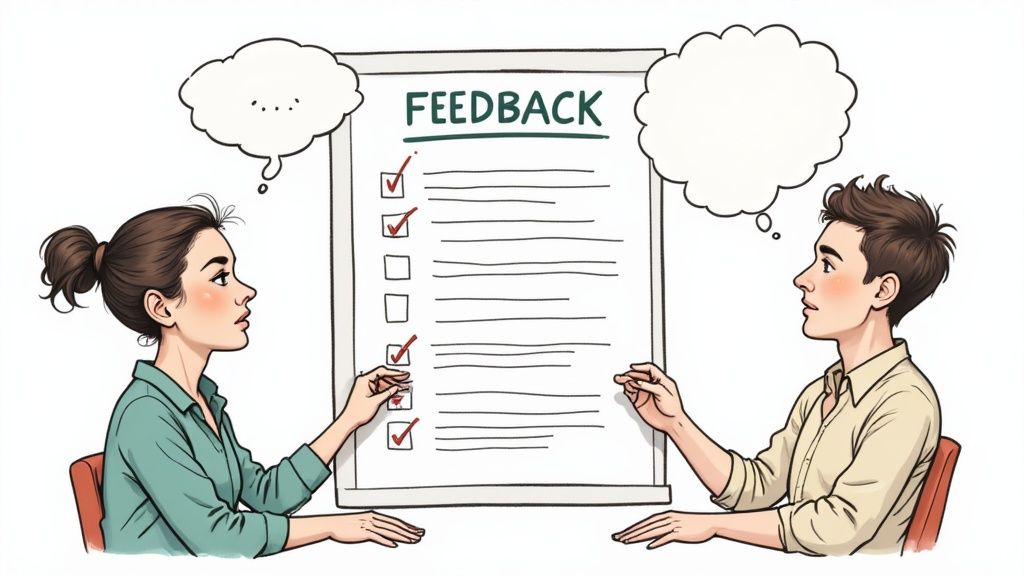
Data plays a vital role in evaluating ideas. However, relying solely on numbers doesn't provide a complete picture. Truly innovative ideas often possess qualities that are difficult to measure.
This means a thorough evaluation needs to explore the qualitative aspects that complement a data-driven approach. This involves understanding the human element, bringing in nuanced perspectives that pure data often misses.
Gathering Qualitative Insights
Several techniques can unlock valuable qualitative data. Structured expert interviews, for instance, leverage specialized knowledge within your organization or industry. These interviews offer valuable perspectives on an idea's potential and challenges, drawing on the experience of those deeply familiar with the field.
Stakeholder feedback sessions are another valuable tool. They gather diverse perspectives from those affected by the idea. This input is critical for identifying potential obstacles and refining the idea to meet everyone's needs. Early customer feedback during product development, for example, can prevent costly mistakes down the line.
Finally, scenario planning explores how an idea might fare under different future conditions. This approach assesses resilience and adaptability, factors rarely captured by numbers alone.
Aligning Ideas With Values
Leading organizations like IDEO and Microsoft go beyond simply measuring market value. They consider how well an idea aligns with their organizational values and culture. This helps identify potential internal resistance that could hinder implementation.
An idea that clashes with a company's commitment to sustainability, for example, might face internal pushback, even if it promises significant financial returns.
Balancing Quantitative and Qualitative
Successful idea evaluation hinges on balancing quantitative data and qualitative judgment. Many organizations have discovered transformative ideas by considering both. These are often ideas that a purely data-driven approach would have overlooked.
For instance, a product idea with low initial market projections might reveal significant long-term potential through user feedback and scenario planning.
Documenting Qualitative Data
Documentation frameworks are crucial for maintaining consistency and rigor. These frameworks offer a systematic approach to capturing and organizing qualitative insights, ensuring consistency across different ideas and teams.
This creates a system that leverages human insight without sacrificing analytical depth. Consistent documentation simplifies comparisons between ideas and helps track progress.
By incorporating quantitative and qualitative dimensions, idea evaluation becomes a more robust process. It leads to better innovation outcomes. According to The BetterIdeas Project, marketers who inspire their agencies are 3X more likely to feel proud of their work, highlighting the importance of effective evaluation.
It also found that getting a signed-off idea typically takes 5 rounds of development, up from 3 in 2007. Only 10% of ideas are evaluated against clear criteria. These statistics reveal significant room for improvement in current evaluation processes.
Building Your Dream Team for Evaluation Excellence
Even with the most well-defined evaluation frameworks, the success of your innovation process ultimately depends on the people involved. Assembling the right team is crucial for effectively evaluating ideas and ensuring the most promising concepts get the attention they deserve. This means carefully considering the team's composition, individual expertise, and how to best manage the inevitable human element.
Diversity of Perspective: The Key to Unlocking Potential
Building a diverse evaluation team is paramount. A team with varied backgrounds, experiences, and skill sets brings a richer perspective to the evaluation process. This multifaceted approach helps uncover hidden potential and identify blind spots that a more homogenous team might miss.
For instance, including members from different departments like marketing, engineering, and finance, offers a well-rounded view of an idea's feasibility and market viability. This cross-functional collaboration leads to a more robust and comprehensive evaluation.
Expertise Mix: Matching Skills to the Challenge
Different ideas require different kinds of expertise. If you're evaluating a software concept, having software engineers on the team is essential. For a marketing campaign, seasoned marketers offer critical insights.
Aligning the team's expertise to the specific idea ensures a more informed and effective assessment. This targeted approach maximizes the value of each team member's knowledge and experience.
Minimizing Unconscious Bias: Leveling the Playing Field
Unconscious biases can significantly impact evaluations. Implementing strategies to mitigate these biases is key for fair and objective assessments. Blind evaluations, where the origin of an idea is anonymous, help minimize biases related to the idea's source.
Establishing clear evaluation criteria and using structured scoring rubrics also helps maintain objectivity. This structured approach creates a level playing field for all ideas.
Evaluation Workflows: From Rapid Screening to Deep Dives
Different stages of idea development require different evaluation approaches. Early-stage ideas benefit from rapid screening processes to quickly identify high-potential concepts. This allows you to efficiently focus resources on the most promising ideas.
As ideas mature, more thorough assessments involving detailed analysis and stakeholder feedback become necessary. This deeper dive provides a more nuanced understanding of the idea's potential.
Navigating the Politics of Evaluation
The evaluation process isn't always purely objective; political dynamics often come into play. Managing these dynamics effectively is crucial for maintaining team morale and a healthy work environment.
This means providing constructive feedback to everyone who submitted ideas, even if their idea wasn't selected. Transparency in the decision-making process also mitigates potential conflicts and builds trust within the team.
Feedback Loops: Continuous Improvement for Ideas and Processes
Feedback loops are vital for refining both the ideas being evaluated and the evaluation process itself. Regularly gathering feedback from team members and idea submitters identifies areas for improvement. This continuous improvement ensures the process remains effective and relevant.
For more on incorporating feedback, check out this guide on developing a customer-led growth strategy. It offers valuable insights into leveraging feedback for product development.
Case Studies: Learning From the Best
Companies like Netflix and Salesforce are renowned for their innovative cultures. They’ve developed successful idea evaluation processes that prioritize rigor without stifling creativity. Studying these real-world examples offers valuable lessons.
Research from The BetterIdeas Project shows that marketers who feel they inspire their agencies are three times more likely to be proud of their work. They also found that only 10% of ideas are currently evaluated using clear criteria. This highlights significant room for improvement in evaluation approaches and the impact of effective evaluation on team satisfaction and the quality of outcomes.
By focusing on these key elements, you can build an evaluation dream team that consistently identifies promising ideas and fosters innovation. This approach cultivates a culture of constructive feedback and continuous improvement, ultimately leading to better ideas and a more dynamic innovation process.
Turning Great Ideas Into Real-World Wins
The journey from a brilliant idea to tangible success can be challenging. The key connection between an initial concept and real-world impact lies in effectively evaluating ideas. This section explores how to turn promising concepts into actionable plans, and ultimately, achieve real-world success.
From Evaluation to Actionable Insights
Effective evaluation doesn't simply identify good ideas; it also reveals potential roadblocks early in the process. By proactively addressing risks, resource requirements, and stakeholder concerns during the evaluation phase, you significantly increase the likelihood of successful implementation. This proactive approach minimizes the chances of encountering unexpected obstacles later on, when they become more expensive and disruptive to resolve.
For example, consider a new product idea that scores high on innovation but low on market feasibility during evaluation. This early identification allows the team to adjust and refine the concept, perhaps by targeting a niche market, before substantial investment in development.
Building a Roadmap for Success
Innovation leaders recognize the importance of translating evaluation insights into concrete actions. This involves developing detailed implementation plans that outline specific steps, timelines, and assigned responsibilities. A clear roadmap ensures everyone is aligned and working towards a shared objective.
Staged funding models are a valuable tool in this process. By linking continued funding to the achievement of predefined milestones, you encourage progress and establish checkpoints for re-evaluation. This adaptable approach allows for adjustments throughout the project, minimizing wasted resources if the project deviates from initial projections.
Adapting and Refining: Preserving the Core Value
Evaluation feedback often requires adapting the initial idea. The challenge is to preserve the idea's core value while incorporating necessary adjustments. This delicate balance necessitates carefully considering the evaluation data and a willingness to compromise without losing the essence of the innovation. It's similar to sculpting – starting with a raw form and refining it based on your vision, constantly adapting as you progress.
Maintaining momentum during the transition from concept to reality is crucial. Regular communication and acknowledging small victories keep the team engaged and motivated, even when facing setbacks. This sustained enthusiasm drives progress and helps overcome the inherent challenges of bringing new ideas to life.
Securing Buy-In: The Power of Persuasion
Finally, evaluation data becomes a powerful tool for securing support. A strong business case, based on the insights from the evaluation, can persuade even the most skeptical stakeholders. This data-driven approach showcases the idea's potential value and justifies the resources needed for successful implementation.
Aligning cross-functional teams around a shared vision is equally critical. Clearly communicating the evaluation results and how they inform the implementation plan ensures everyone understands the rationale behind decisions and collaborates towards the common goal.
Securing executive sponsorship is often the final step. By presenting a well-structured plan supported by solid evaluation data, you improve the chances of gaining essential leadership support. This backing provides the necessary resources and authority to advance the idea, transforming a promising concept into a tangible achievement.
By mastering these techniques, you transform the evaluation of ideas from a critical checkpoint into a springboard for innovation. You will not only identify winning concepts but also equip your team to navigate the complexities of implementation, ultimately turning great ideas into real-world wins.
Ready to optimize your product development and gather valuable user feedback? Discover how Saylo can help bring your best ideas to life. Visit Saylo today.